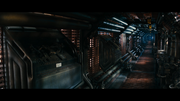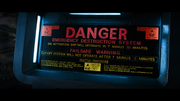The Lockmart CM-88B Bison was a type of spacecraft manufactured by the Lockheed Martin Corporation.[1] It found widespread use as both an interstellar cruiser and a deep space cargo transport.[3] In the latter role, the CM-88B operated as a tug, connecting to and pulling loads like a tractor truck rather than carrying those loads on board like a traditional freighter.
Overview[]

A corridor on one of the lower decks of a CM-88B.
Internally, the CM-88B consisted of three pressurized decks and four internal cargo holds, totalling around 1.1 million cubic meters of pressurized volume.[4] Most of the spare space on board was filled with fuel for the ship's fusion reactor and reaction mass for the thrust engines.[3] The upper deck contained the main living areas, including the bridge, crew quarters, mess hall, science station and medical bay with a Autodoc, while the lower decks comprised of extensive engineering and storage areas.[5] The ship was sturdy enough to withstand atmospheric re-entries and had three main landing legs to allow surface landings. Particulate shielding helped to protect the vessel from airborne debris in even the roughest planetary atmospheres.
In-flight systems were governed by the ship's central artificial intelligence computer, MU/TH/UR 6000 (known by the crew as "Mother"). A backup 2.0 terabyte mainframe would come online should Mother fail, while a third tier of automation could sustain vital systems in the rare event of a failure in the backup CPU as well.[3] Despite the extensive computer automation aboard the CM-88B, a human crew was still required for more complicated docking manoeuvres at each end of a transit.
Energy and propulsion[]
The CM-88B's power core was a Laretel WF-15 2.8 terawatt fusion reactor.[4] The power plant operated around a deuterium/tritium reaction that fused the fuel elements in a containment chamber using conversion lasers. The He4 byproduct of the reaction was stored separately and vented at regular intervals. Power was drawn off of the reactor by a closed-cycle liquid potassium cooling system, running off into an induction torus which used the intense magnetic field created by the superheated potassium to generate electric power for the vessel.[4]

The instructions for the Emergency destruction system aboard a CM-88B.
Notably, the CM-88B's reactor possessed a self destruct capability, whereby the reactor's coolant systems could be shut down leading to a runaway reaction in the containment sphere and eventual catastrophic detonation. Once the process was begun, there was a five-minute failsafe period during which time the coolant system could be successfully reactivated.[5] However, after this period had expired, the supercritical reaction became unstoppable and after a further five minutes the reactor would explode. Activation of the self destruct could only be carried out by an authorized crew member, and the procedure sequence was sufficiently complex to prevent accidental activation.

A CM-88B's engines.
Faster-than-light travel was accomplished through a Yutani T7A NLS tachyon shunt drive, capable of propelling the CM-88B to a cruising speed of 0.42 light-years per sidereal day when the ship was unladen.[4] When towing large mass cargoes such as automated refineries, the maximum sustainable cruise speed drops significantly, to around 0.1-0.12 light-years per sidereal day.[4] For manoeuvring at sublight speeds while towing a large mass, the CM-88B was outfitted with Saturn J-3000 engines.
Communications[]
The standard communications set up aboard a CM-88B comprised 10 and 4 meter hyperstate antennas for any interstellar communications and UHF/VHF/HF radio/video links for short-range links. Navigational sensors were mounted on pylons clustered around the forward hull of the ship and included two 2 m aperture telescopes capable of optical, spectrographic and infrared resolution, a gas chromatograph, centimetric navigation and landing radar, a synthetic aperture ground mapping radar and a mass counter for supralight navigation.[4]
Weaponry[]
As a towing vessel, the CM-88B was not equipped for primary combat. However, individual weaponry was part of the basic equipment stored for the crew's use, especially during extravehicular activity in unknown sectors.[6]
Notable Ships[]
Appearances[]
- Alien
- Aliens: Colonial Marines Technical Manual (mentioned only)
- Alien: The Roleplaying Game — Chariot of the Gods
- Aliens: Dark Descent
References[]
- ↑ 1.0 1.1 1.2 1.3 Graham J. Langridge. Alien: The Blueprints, p. 17 (2019), Titan Books.
- ↑ 2.0 2.1 2.2 S. D. Perry. Alien: The Weyland-Yutani Report, p. 66 (2014), Insight Editions.
- ↑ 3.0 3.1 3.2 Lee Brimmicombe-Wood. Aliens: Colonial Marines Technical Manual, p. 135 (2012), Titan Books.
- ↑ 4.0 4.1 4.2 4.3 4.4 4.5 Lee Brimmicombe-Wood. Aliens: Colonial Marines Technical Manual, p. 136 (2012), Titan Books.
- ↑ 5.0 5.1 Dan O'Bannon, Ronald Shusett (writers), Ridley Scott (director). Alien (1979), 20th Century Fox [DVD].
- ↑ Aliens: A Comic Book Adventure User's Manual
